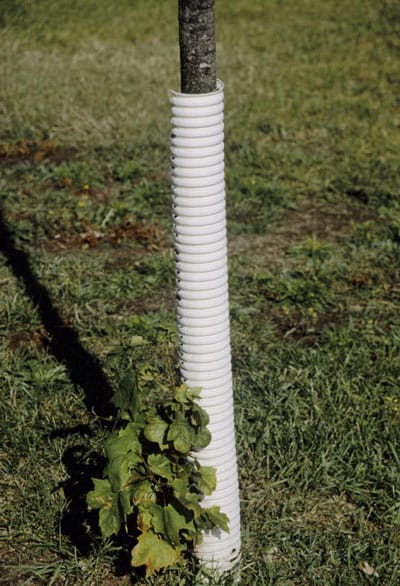Winter is on its way, and with it will come colder temperatures, dry spells, and snow and ice. You probably won’t be surprised to learn that those things can all have a negative impact on your broadleaf evergreens, which is why we recommend anti-desiccant spray for them.
But did you know that another thing to watch out for during the winter months is something called sunscald? Deciduous trees (those that lose their leaves in winter) are most likely to suffer from this, as they’ve lost the protective cover of their leaves. It’s also known as “southwest winter injury,” as it affects the south or west side of trees.
What is sunscald or southwest winter injury?

Sunscald on the southwest side of a young tree. Image by Joseph OBrien, USDA Forest Service, Bugwood.org
Here’s how it works: without their leafy cover, the branches and especially the trunks of trees are exposed to higher temperatures from direct sunlight. The sunlight warms up the tree on the south and west sides, causing the tree to wake out of dormancy. When the temperatures again plummet – either because of the sun going behind a cloud or because of the sun setting – the tree, which was expecting a continual warm summer day, is not prepared to deal with the extreme temperature change.
Temperature differences between the north and south side of trees can be as much as 77 degrees – that means that when it’s 20 degrees outside, the south side of the tree exposed to the sun can be over 80 degrees.
The cells just inside the outer bark (called the phloem and cambium) in the trunk are killed by this temperature-induced stress, which is problematic because those are the cells that carry needed food to the tree.
What trees are affected by sunscald?
Most young trees, along with varieties of trees that have thinner bark are those most likely to be affected by sunscald injury, including:
- Apple
- Cherry
- Ash
- Cottonwood/Poplar
- Aspen
- Honeylocust
- Birch
- Crabapple
- Maple
- Linden/Basswood
- Mountain-ash
- Oak
- Peach
- Tuliptree
- Willow
Evergreen trees are less likely to suffer from sunscald injury because their needles protect against the sun – unless the lower branches are removed, leaving the bottom of the trunk exposed to sunlight.
Trees that have been moved from shade into full sun, pruning the lower branches on a tree, or removing a tree or building that was shading the trunk can all cause sudden sunscald damage.
How do you know if your tree has sunscald?
The bark will show telltale signs of sunscald injury. Look for the following:
- bark that is cracking or discolored
- sunken areas where the bark is no longer growing
- bark that is falling off, revealing dead tissue underneath
Preventing Sunscald Injury

Use a simple tree wrap to prevent winter sunscald damage. Image by Joseph OBrien, USDA Forest Service, Bugwood.org
Healthy trees have a better chance of recovering from sunscald, so ensuring that your trees are healthy, well-cared-for, and fully hydrated before the ground freezes will help.
Keep lower branches on young trees for a few years until they grow thicker bark to protect themselves.
If you have a young tree or a variety of tree with thinner bark, find some way to block it from the sun in winter, such as planting it in shade, covering it with a white tree wrap, or shading it with a light-colored board or fence on the south and west sides of the tree. Some fruit tree trunks can be painted white to reflect the sun and keep the tree tissue cooler, but opinion differs on whether this prevents the tree from breathing well or not.
Note about tree wraps: Tree wraps should be applied in late fall but removed in spring after the last hard frost. If they’re not removed soon enough, they can attract insects and prevent tree diameter growth.
Finally, check out our winter tree care tips for other ways to keep your trees safe during winter.
Treating Sunscald
Again, the overall health of a tree largely determines whether it will survive if it gets sunscald. Keeping the tree as healthy as possible will help it to recover.
Bark that’s been damaged by sunscald will eventually peel off, sometimes removing the dead tissue underneath, revealing the underlying wood of the tree. This can expose the tree to pests and diseases, so keep a close watch for any fungi or insect infestations.
Keep the tree well hydrated, especially during summer.
Note: Trees can also suffer from sunburn, which happens during the summer months.
Header image shows sunscald damage on the trunk of a green ash. Image by William Jacobi, Colorado State University, Bugwood.org.
Get helpful tips, local news, inspiring stories, and more delivered right to your inbox every month. Don't miss another issue - join today!





